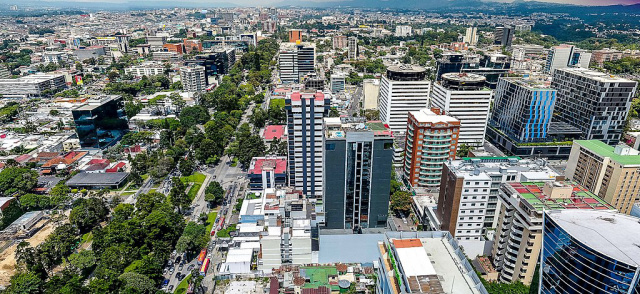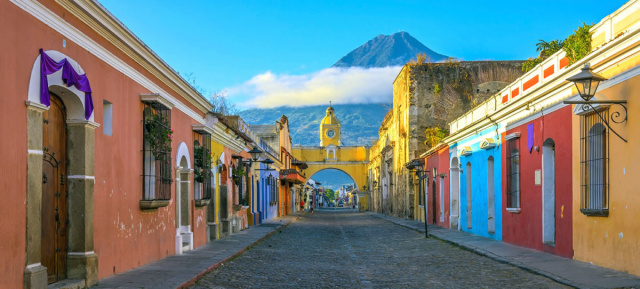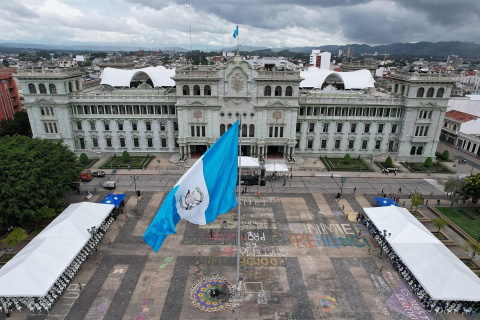Guatemala City, often referred to as “Guate,” is the vibrant capital and largest city in Central America, home to approximately three million people. Situated on a high plateau at about 1,500 meters (4,900 feet) above sea level in the western highlands, it’s surrounded by mountains and active volcanoes, offering a mix of urban energy, historical sites and cultural richness.

Founded in 1776 after earthquakes destroyed previous capitals, the city was built over the ancient Maya site of Kaminaljuyú. Today, it’s divided into 21 distinct zones, each with its own personality: Zona 1 is the historic heart with colonial architecture, Zona 4 boasts a bohemian vibe with street art and cafes, and Zonas 9 and 10 (known as Zona Viva) are upscale areas filled with museums, shopping, and nightlife.
As a gateway to Guatemala’s diverse landscapes—from Mayan ruins to volcanic hikes—the city reflects the country’s blend of Indigenous (about 45% of the population) and modern influences. However, it’s also known for its challenges, including traffic congestion and safety concerns, so visitors often use it as a base for day trips rather than an extended stay.
Guatemala City enjoys a temperate climate year-round due to its elevation, with average daytime temperatures around 20–25°C (68–77°F) and cooler nights. The year is divided into two main seasons: the dry season (November to April) and the wet season (May to October).
The dry season is generally the best time to visit, offering sunny skies, minimal rainfall, and comfortable conditions for exploring outdoors and nearby volcanoes. Peak months include December to February for holidays and milder weather, though mornings can be chilly in January.
Events like Christmas celebrations in December add festive cheer. The wet season brings afternoon showers, lush greenery, and fewer crowds, making it ideal for budget travelers—May and September see lighter rains and cultural highlights like Independence Day on September 15. However, heavy rains in August can cause flooding, so pack accordingly. Avoid the height of the wet season if planning hikes, as trails can become slippery.
Weather overview
| Month | Average High/Low (°C) | Rainfall | Notes |
|---|---|---|---|
| January | 23/12 | Low | Cool mornings; dry and sunny. |
| April | 27/15 | Low | Warmest dry month; Semana Santa events. |
| July | 24/16 | High | Frequent afternoon rains; lush but humid. |
| October | 23/15 | High | End of wet season; potential for storms. |
| December | 23/12 | Low | Festive; cool evenings. |
Packing tips: Lightweight clothing, a fleece for evenings, sturdy shoes for walking, and sunscreen. In the wet season, include a waterproof jacket, quick-dry clothes, and a dry bag. Always bring insect repellent, a reusable water bottle, and personal medications.
Guatemala City’s main international gateway is La Aurora International Airport (GUA), located in Zona 13, about 6 km (4 miles) south of the city center. It’s served by major airlines like American, Delta, United, and Avianca, with direct flights from cities such as Miami, New York, Mexico City and Madrid.
Upon arrival, use official INGUAT-approved taxis from the “SAFE” stand, Uber, or pre-arranged hotel shuttles to reach your accommodation – expect a 20-40 minute ride depending on traffic. No visa is required for U.S. citizens staying up to 90 days; you’ll need a valid passport and must complete an electronic immigration and customs form online before travel. Overstays incur a small daily fine. For land entry from neighboring countries like Mexico, El Salvador, or Honduras, buses and shuttles are common, but opt for reputable companies like Fuente del Norte for safety.
Navigating Guatemala City can be chaotic due to heavy traffic, so avoid renting a car. Taxis are the most convenient option: Use regulated services like Taxi Amarillo Express, Taxi Seguro, or Uber for safety and metered fares (rides within the city cost about 50–100 GTQ/$6–13). The Transmetro bus system is affordable (about 1 GTQ/$0.13 per ride) and safe, but routes are limited to major corridors. For a local experience, colorful “chicken buses” (repurposed school buses) connect zones cheaply, though they’re crowded and not recommended for tourists due to pickpocketing risks.
Walking is feasible in safer areas like Zona Viva or Paseo Cayalá, but always in daylight and groups. For day trips to nearby Antigua or Lake Atitlán, book shuttles through services like GauteGo. U.S. government employees are restricted from using public transport, highlighting general caution.
Accommodations in Guatemala City range from luxury hotels in Zona Viva to budget options in Zona 1. For safety and convenience, stay in Zonas 9, 10, or 14, which offer modern amenities and proximity to attractions. Top picks include:
Hyatt Centric Guatemala City (Zona 10): Upscale with rooftop views, starting at $150/night.
Hotel Clarion Suites (Zona 10): Comfortable mid-range with breakfast, around $100/night.
Hostal Los Lagos (near airport): Budget-friendly for layovers, about $30/night.
Look for properties with secure parking, doormen, and 24/7 security. Airbnb is available but verify reviews for safe neighborhoods. Book in advance during dry season peaks.

Guatemala City blends history, culture and nature. Here’s a curated list of must-sees:
| Attraction | Description | Rating (TripAdvisor) | Tips |
|---|---|---|---|
| Paseo Cayalá | A pedestrian-friendly district with European-style architecture, shops, cafes, and green spaces—perfect for a relaxed stroll. | 5/5 | Visit in the evening for lights and dining. |
| La Aurora Zoo | A well-maintained zoo showcasing native wildlife like jaguars and birds; includes dining areas. | 4/5 | Family-friendly; go early to avoid crowds. |
| Museo Popol Vuh | On Universidad Francisco Marroquín campus, features an extensive collection of Maya artifacts with English labels. | 5/5 | Combine with nearby Ixchel Museum. |
| Museo Ixchel del Traje Indígena | Highlights Indigenous textiles, ceramics, and jewelry, preserving Guatemalan traditions. | 4/5 | Insightful for cultural enthusiasts. |
| Volcán Pacaya | Hike this active volcano (about 1.5 hours from the city) for lava views; guided tours essential. | N/A | Book a tour; wear sturdy shoes. |
| Plaza de la Constitución (Zona 1) | Historic central square with the National Palace and Cathedral; great for people-watching and photos. | N/A | Avoid after dark. |
| Kaminaljuyú Ruins | Ancient Maya site within the city; observe rituals and explore mounds. | N/A | Hire a guide for context. |
| Mercado Central | Underground market for handicrafts, textiles, and street food like pepián (national stew). | N/A | Bargain; join a food tour. |
Other activities include volcano watching (e.g., Volcán Fuego eruptions visible from the city) and day trips to Antigua (45 minutes away) for colonial charm.
Guatemalan cuisine emphasizes fresh ingredients like corn, beans, and chiles. In Guatemala City, dine in safer zones like Zona Viva or Paseo Cayalá. Must-tries include pepián (spicy meat stew), kak’ik (turkey soup), and street tacos. Top spots:
Mercado Central (Zona 1): Authentic stalls for local dishes; open 6 a.m.–6 p.m., cheaper on weekdays.
Restaurante Altuna (Zona 10): Upscale Spanish-Guatemalan fusion; try the paella.
Café de los Deseos (Zona 4): Bohemian cafe for coffee and light bites amid murals.
Vegetarian options are growing, but confirm with “sin carne” (no meat). Water is not potable—stick to bottled. For safety, eat at busy places and avoid street food if you have a sensitive stomach.
Safety Tips
Guatemala City has a high crime rate, including robbery and carjacking, so exercise caution. Reconsider travel to high-risk areas like Zone 18 or Villa Nueva; stick to tourist zones (Zonas 1, 4, 9, 10). Avoid walking alone at night, displaying valuables, or using public ATMs—use hotel safes. Don’t hail random taxis; opt for Uber or vetted services. Be vigilant during demonstrations, which can turn violent. For emergencies, contact ASISTUR (tourist assistance) at 1500 or +502-2290-2810 (24/7), or the U.S. Embassy. Health-wise, get CDC-recommended vaccines (hepatitis A/B, typhoid); avoid tap water and unpeeled fruits. Mosquito-borne illnesses like dengue are risks – use repellent. If hiking, always with a certified guide.
Additional Tips
Currency and Costs: Use quetzales (GTQ); ATMs are widespread but use indoors. Budget $50-100/day for mid-range travel.
Language: Spanish is official; learn basics like “gracias” (thank you). English is spoken in tourist areas.
Connectivity: Buy a local SIM (Tigo or Claro) at the airport for data.
Sustainability: Support eco-tours and avoid single-use plastics.
Health Updates: Check current requirements; no entry restrictions as of 2025, but mask in crowds if advised.
Guatemala City is as a worthwhile stop for its cultural depth. Have a joyful travels with Preems Travel Guides!
© Times of U

